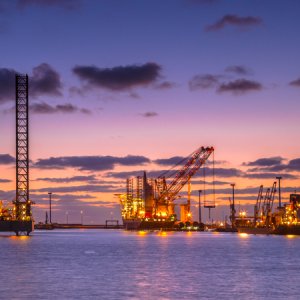How Technological Dynamism Aids Operators During Difficult Times

STORY INLINE POST
Q: What impact will the Saudi Arabia-Russia oil price war and the subsequent plunge in prices as well as the COVID-19 situation have on operators in Mexico?
A: We first need to understand the context of these two issues. Although both are having a negative impact on the oil and gas industry, they are otherwise wholly unrelated. The 2014 price drop and fallout from that prepared us in some way for what could happen with the current oil price decline. The key discussion back then for all oil companies related to implementing cost reductions. That discussion never went away and all companies have remained cost-conscious. That led to several reorganizations and a more careful focus on what technology can do for us.
The technology element in particular represented a disadvantage for those companies that depended on manual processes and were thus unprepared for this shift. Now, all companies in all categories and segments of the industry’s value chain have acknowledged this truth and they all have a digital transformation strategy. Although the strategy varies from company to company, they all share the ultimate objective of revenue maximization.
This does not mean that the current drop in oil price is not scary. We should be scared but we need to be scared in a smart way. We need to acknowledge that we have done things in the past that can help us now. We have options to further reduce costs and time frames. We survived 2014, 2015 and 2016, and we came out of that stronger than ever. This is particularly true of Petrolink because of the way we can reduce these time frames for our clients through technology. I am sure that we will see budgetary reductions, and we will see this in larger companies that have a harder time adapting. This was one of the lessons of 2014 that needs to be applied to all of these issues: the vital importance of adaptability and dynamism, of operating under the assumption that whatever is coming tomorrow or next week is impossible to predict. We have an idea of the different scenarios that could impact the industry to varying degrees of catastrophic consequences, but the difference between those events can be enormous.
In terms of the coronavirus, Petrolink is a 700-employee company, which is relatively small when compared to major players in the oil industry, but even for us, dynamic and adaptable planning is not easy to achieve, especially given the various levels of service and support that we need to be able to guarantee for our clients. It is important that we know their plans and requirements. We need to know what they will do if an outbreak takes place tomorrow. There is no need to panic, you just need to be prepared. I am confident that the industry will be able to face this. The industry has been making plans since before the first COVID-19 case in the US was confirmed.
Q: How do you address companies that were already hard to convince to take on new technologies in the midst of a crisis?
A: All companies will face considerable risk because of these situations. Budgets will be reduced or even cut altogether. We need to do what we have done in the past, which is to continually prove and demonstrate the economic benefits of implementing our technologies. We want our clients to see continuous improvements in their balance sheets and a quick return on their investment in us. We also need to emphasize the degree to which the whole industry needs to reduce its dependency on manual processes. Internal workflows and processes need to be as automated as much as possible to reduce costs and increase efficiencies, for both our clients and ourselves.
When we began accelerating these developments internally after 2014, there was interesting collateral effect: we ended up developing technologies and software solutions for our own needs that we could offer to companies not only as a service provider but as a product to be purchased or licensed. Those new modalities were not in our strategy two or three years ago. We started to explore these possibilities in other markets, but Mexico was our original pilot for this and now it is a proven success. We have, in fact, entered countries where we had no previous presence whatsoever and established ourselves by selecting strategic partners that could have a use for these software solutions and technologies. In Mexico, we still have a contract with PEMEX, but we have also diversified beyond it by exploring the alignment between these options and the needs of other companies.
We want to enable oil and gas operators to open new lines of business and offer new services thanks to the problems they could solve through our products. We have contracts signed here in Houston with international oil companies now operating in Mexico to directly support them in their projects in Mexico. At the same time, in Mexico, local oil companies use our technologies not because they have a contract with us but because these strategic partners made it easier for them to use it. That is an advantage for us. We would obviously prefer to work with these clients through direct contracts, but what we have achieved through this variety is more important, which is an increase in market share. In this regard, Mexico is the success story to be replicated in other countries.
Q: What differences have you perceived in the technological literacy and preparedness of the Mexican workforce?
A: The answer to that question three years ago was that the differences were enormous, particularly in a generational sense. The difference was also large between PEMEX and private operators. Companies like ENI and Shell have matured and faced extreme experiences in diverse locations around the globe in ways others have not. They have different baselines when it comes to the use of technology and their databases of technological vendors. It makes sense for NOCs to be more static than IOCs, to be more stable and provide more continuity at the cost of market dynamism. They have a specific role to play as public institutions. However, over the last two years, these things have begun to change. Perceptions of the Mexican industry have changed, which has led to a higher degree of technological exchanges of knowledge and experiences.
Q: Where and how in Mexico is Petrolink making the greatest impact?
A: Prior to the unprecedented COVID-19 situation, Petrolink had already proven to be a reliable partner for all remote real-time monitoring and assessment needs. As this COVID-19 situation evolves and puts our capacities to continue supporting our customers to a test, it is very satisfying to evidence that our investments in resources, infrastructure and technology, along with our qualified and service-oriented staff, are allowing customers to continue monitoring their drilling operations even when optimal business conditions are being challenged.
Any new production, that is, any new drilling campaign in mature onshore fields must imply faster, less expensive wells. Petrolink’s portfolio of real-time solutions allow for a better assessment of the operation and thus for addressing in a timely manner any unexpected situation that could compromise the above premises.








 By Peter Appleby | Journalist and Industry Analyst -
Mon, 04/20/2020 - 13:45
By Peter Appleby | Journalist and Industry Analyst -
Mon, 04/20/2020 - 13:45















